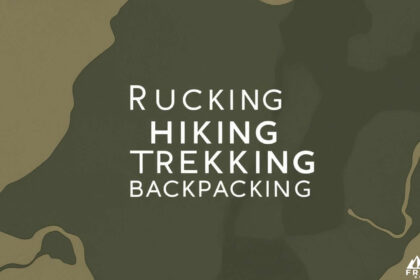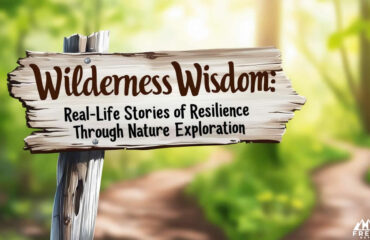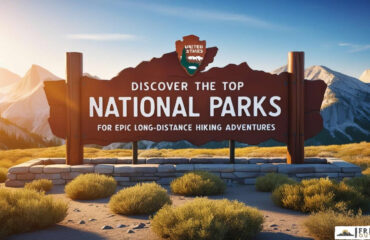
Key differences between rucking, hiking, trekking, and backpacking to enhance your outdoor experiences and fitness journey.
Understanding Outdoor Activities: Rucking, Hiking, Trekking, and Backpacking
Outdoor activities have seen a remarkable surge in popularity, especially as more individuals seek to merge fitness with exploration. Rucking, hiking, trekking, and backpacking are four distinct yet interconnected activities that cater to different preferences, fitness levels, and outdoor objectives. This article aims to clarify the distinctions among these activities to enhance outdoor experiences and provide clear insights into what each has to offer. As people increasingly focus on healthier lifestyles, understanding these differences can significantly aid in choosing the right activity that aligns with personal fitness goals and adventure preferences.
For instance, a beginner interested in outdoor fitness may find a local hiking trail appealing, while a seasoned athlete might be drawn to rucking as a way to add intensity to their workouts. Each activity provides unique challenges and rewards, making them attractive to a wide spectrum of outdoor enthusiasts. Additionally, the rising trend of wellness and outdoor exploration has paved the way for communities that promote these activities, fostering social connections and shared experiences among participants.
What is Rucking?
Rucking is defined as walking with a weighted backpack , typically carrying 20-60% of one’s body weight. This form of exercise promotes not only physical endurance but also strength and mental toughness. Unlike hiking, which is generally leisurely, rucking is structured with specific distance or time targets, making it a more intense workout. For example, a participant might aim to complete a 5-mile ruck with a 40-pound pack, pushing their limits both physically and mentally. This structured approach not only challenges the body but also cultivates a strong sense of achievement upon completion.
Rucking offers considerable calorie-burning potential, with the ability to burn up to three times more calories than regular walking, depending on the weight carried. The activity can be performed on various terrains, including urban settings, trails, and parks, enhancing its adaptability and challenge. Popular events like the GoRuck Challenge have gained traction, encouraging community participation and motivating individuals towards their fitness goals. This event not only tests physical endurance but also fosters camaraderie among participants. Rucking requires minimal gear, making it accessible to beginners who only need a rucksack and weights to get started.
Moreover, rucking offers additional benefits such as improved posture and back health due to the emphasis on proper shoulder alignment while carrying weight. Many military personnel use rucking as a training method, highlighting its effectiveness in building strength and endurance. Newcomers can easily incorporate rucking into their fitness routines, starting with lighter weights and gradually increasing as their confidence and strength grow. Engaging in rucking encourages individuals to step outdoors, breathe fresh air, and get fit, all while enjoying the benefits of nature.
What is Hiking?
Hiking is often characterized as a long walk on established trails, primarily for leisure and exercise, with durations ranging from a few hours to a full day. The trails are usually well-marked and accessible to various fitness levels, making hiking a family-friendly activity suitable for all ages. For example, a family might enjoy a scenic hike in a local park, benefiting from both the physical activity and the quality time spent together. Hiking can include leisurely strolls through nature reserves or more challenging ascents in mountainous regions, showcasing the diversity of this beloved outdoor pastime.
Hiking typically burns approximately 430-480 calories per hour, depending on the terrain and intensity. It can be done solo or in groups, providing opportunities for social interaction and community building. Various types of hiking exist, including day hikes, section hikes, and multi-day hikes, which reflect different levels of commitment. Safety precautions, such as carrying a first aid kit and proper navigation tools, are essential for ensuring a successful hike. For instance, a group of friends embarking on a day hike can benefit from shared supplies and a communal approach to safety, enhancing their overall experience.
Furthermore, hiking can also serve as a platform for environmental education, allowing individuals to appreciate nature while learning about local ecosystems. Many parks offer guided hikes where participants can gain insights into the flora and fauna of the region. The accessibility of hiking makes it an ideal entry point for individuals new to outdoor activities, providing a sense of accomplishment as they explore the great outdoors. The combination of physical activity and nature immersion promotes mental well-being, helping hikers to relieve stress and increase their mood.
What is Trekking?
Trekking is distinguished from hiking by its multi-day outdoor journeys through rugged terrains, which require a higher level of endurance and preparation. Trekkers often navigate unmarked paths and face challenging conditions, emphasizing the need for navigation skills and personal resilience. For example, trekkers on the Inca Trail may spend days traversing mountains and ancient ruins, requiring both physical stamina and mental fortitude. The experience often fosters a deeper connection to the environment and a sense of adventure that extends beyond mere physical challenge.
Due to its increased physical demands, trekking may burn around 500-700 calories per hour. It often includes overnight camping, necessitating specialized gear like sleeping bags and tents for comfort. Popular trekking routes, such as the Appalachian Trail, showcase diverse landscapes and cultural experiences, making trekking not just a physical challenge but also an enriching journey. Trekkers often form tight-knit communities, sharing experiences and tips for navigating both the terrain and the emotional ups and downs that accompany long-distance trekking.
Additionally, trekking requires a significant amount of preparation, including training and research on trail conditions and weather. Many trekkers engage in pre-trek conditioning to build the necessary stamina for their journeys. For instance, someone planning a trek to Everest Base Camp will often train for weeks, focusing on cardiovascular fitness, strength training, and hiking practice. This level of preparation not only helps ensure safety but also enhances the overall enjoyment of the trek, as participants feel more confident in their abilities to tackle challenging terrain and variable weather conditions.
What is Backpacking?
Backpacking is a unique blend of hiking and camping, where individuals carry all necessary supplies for multi-day trips. This activity requires specialized gear such as high-quality backpacks and tents, allowing for deeper immersion in nature. For instance, a backpacker planning a weekend trip to Yosemite would need to pack food, water, and camping gear, enhancing their connection with the wilderness. Backpacking is an adventure that often leads to discovering hidden gems in nature, such as secluded lakes or breathtaking vistas that are not accessible by car.
Backpacking encourages a minimalist approach to gear, focusing on lightweight and multifunctional items to ease transportation. Trips can vary in length, from weekend getaways to extended adventures spanning weeks. The culture surrounding backpacking includes communities and meet-ups where enthusiasts share tips, experiences, and trail recommendations. This sense of community can foster friendships and provide support for individuals embarking on their backpacking journeys.
Moreover, backpacking also promotes self-reliance and resourcefulness, as individuals must learn to manage their supplies and navigate unfamiliar areas. A common backpacking trip might require participants to plan their meals, ensure they have adequate water, and be prepared for any changes in weather. The ability to adapt and think critically while in the wilderness enhances the sense of accomplishment that comes with completing a backpacking journey. Backpacking can also serve as a transformative experience, allowing individuals to disconnect from their daily lives and reconnect with nature, which has been shown to improve mental health and overall well-being.
Key Differences Between Rucking and Hiking
The main differences between rucking and hiking lie in the nature of the activity and the weight carried. Rucking typically involves carrying heavier loads (20-60% of body weight), while hiking usually entails lighter packs (20-25% of body weight). Rucking is more physically intense and can be performed at a faster pace, whereas hiking is generally more leisurely and exploratory. Rucking sessions are often structured with specific goals, contrasting with the more relaxed nature of hiking, which focuses on enjoying the scenery and nature.
For example, a rucker may set a goal to complete a specific distance or time under a particular weight, while a hiker may simply enjoy the sights and sounds of the trail without a strict agenda. Both activities can complement each other, enhancing overall physical conditioning and endurance. For instance, someone who rucks regularly may find that their hiking experience improves as their strength and stamina increase. The fitness-focused approach of rucking can help prepare individuals for the demands of hiking or trekking.
Moreover, rucking is often integrated into training programs for military personnel, illustrating its effectiveness in building strength and endurance. Many fitness enthusiasts have also incorporated rucking into their routines as a way to challenge themselves and vary their workouts. Rucking offers a dynamic workout that can be done anywhere, making it accessible for those who may not have the time to dedicate to longer hiking trips. The community aspect of rucking events encourages participants to connect with others who share similar fitness goals, creating a supportive environment for both beginners and seasoned ruckers.
Key Differences Between Trekking and Hiking
When comparing trekking and hiking, the differences are significant, particularly in the duration and difficulty of the routes. Hiking trails are generally well-maintained and easier, while trekking paths are often rugged and less defined. Trekking can last several days, demanding more preparation and endurance, whereas hiking typically involves shorter, casual outings. The physical demands of trekking require participants to be more fit and prepared than those hiking on established trails.
For example, a hiker may enjoy a simple day hike at a local park, while a trekker might plan a multi-day journey through challenging terrains like the Himalayas. Physical endurance is less critical for hiking, making it more accessible to a wider audience than trekking, which often requires extensive planning, including permits and navigation strategies. The mindset for trekking often includes a greater sense of adventure and personal challenge compared to the more relaxed approach of hiking.
Moreover, trekking often involves cultural immersion, as trekkers frequently encounter local communities along their routes. For instance, a trekker on the Camino de Santiago may engage with local residents, learn about their culture, and even share meals with them. This aspect of trekking adds a rich layer to the experience, allowing individuals to connect with the land and its people. The more demanding nature of trekking also fosters personal growth, as participants learn to overcome physical and mental challenges while navigating the wild.
Key Differences Between Backpacking and Hiking
Backpacking differs from hiking primarily in that it requires carrying all supplies needed for overnight trips, while hiking can be a day trip with minimal equipment. Backpacking allows for exploration of remote areas and often involves a greater sense of adventure, as individuals camp in wilderness settings. The gear used in backpacking is more specialized, including tents and cooking equipment, whereas hiking typically requires simpler gear.
For example, a backpacker may need to carry a stove and cooking gear for meal preparation, while a hiker may only need snacks for a shorter trek. Backpacking trips encourage a deeper connection with nature, as individuals spend multiple days in the wilderness, often seeking new routes and experiences rather than returning to familiar trails. The experience of setting up camp each night and cooking meals outdoors fosters a sense of autonomy and self-sufficiency.
Additionally, backpacking requires knowledge of essential skills like navigation, tent setup, and food storage. A beginner backpacker might start with a guided trip or a workshop to learn these skills before embarking on their own adventure. As they gain experience, individuals often develop their preferences for gear, routes, and camping techniques, tailoring their backpacking experiences to their unique interests and abilities. The diverse experiences available in backpacking—from leisurely trips to challenging ascents—make it a versatile option for outdoor enthusiasts seeking adventure.
Health Benefits of Rucking, Hiking, and Trekking
Engaging in rucking, hiking, and trekking offers numerous health benefits that extend beyond mere physical fitness. Rucking is known to improve posture and back health by promoting proper shoulder alignment while carrying weight. It helps strengthen core muscles and enhances overall endurance, making it a valuable exercise for those looking to increase their physical capabilities. Hiking enhances overall fitness, reduces stress, and improves mood, making it suitable for various skill levels. The rhythmic movement of hiking, combined with fresh air and natural beauty, can lead to a meditative state, fostering mental clarity and emotional well-being.
Trekking contributes to personal growth and cultural immersion while providing significant physical benefits. The challenges presented during long trekking journeys often push individuals beyond their comfort zones, leading to increased resilience and self-confidence. All three activities can lower the risk of heart disease and improve cardiovascular health through regular engagement. The combination of aerobic exercise and weight-bearing activity helps maintain a healthy heart and reduces the risk of chronic illnesses.
Outdoor exposure during these activities enhances mental well-being by reducing anxiety and depression. Research shows that spending time in nature can have calming effects and promote positive mental health outcomes. Additionally, participating in group activities fosters social connections and community involvement, enriching the experience. The camaraderie developed during rucking challenges, hiking excursions, or trekking adventures often leads to lasting friendships and a sense of belonging among outdoor enthusiasts.
Suitable Activities for Beginners
For beginners, hiking is generally more suitable due to its accessibility and lower physical demands. Hiking trails are often well-marked and easy to navigate, which provides a sense of safety for newcomers. Rucking can also be introduced gradually, starting with lighter weights to prevent injury. Beginners can benefit from starting with short rucks, eventually building up their weight as their strength and confidence increase.
Individuals interested in trekking should begin with shorter, well-defined trails before attempting longer journeys. Guided treks or workshops are excellent options for those new to this activity, as they provide valuable instruction on essential skills and preparation. Joining local hiking or rucking groups can provide support and encouragement for newcomers, helping them build confidence and skills. Community engagement through group outings can also enhance motivation and enjoyment of the outdoors.
Investing in proper footwear and gear is crucial for enhancing comfort and safety during these activities. A good pair of hiking boots can significantly impact a beginner’s experience, providing stability and reducing the risk of injury. Beginners are encouraged to participate in guided tours or workshops to learn essential skills and gain confidence in their outdoor adventures. These experiences not only build knowledge but also foster a passion for outdoor activities, encouraging individuals to explore further.
Summary of Distinct Outdoor Activities
Understanding the distinct characteristics and benefits of rucking, hiking, trekking, and backpacking can significantly enhance outdoor experiences. Each activity caters to different fitness levels and adventure preferences, offering unique challenges and rewards. By recognizing the differences among these outdoor activities, individuals can choose the one that best aligns with their goals, leading to potential personal growth and health benefits through regular engagement in the great outdoors. Engaging in these diverse activities can enrich lives and foster a greater appreciation for nature, ultimately contributing to a healthier lifestyle.




